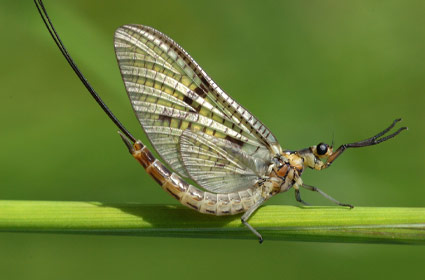To some, mayflies are nothing more than a yearly pest. But to scientists like Don W. Schloesser of the U.S. Geological Survey, they mean a lot more.
 In the 1950s, these insects disappeared from many different areas in Lake Erie — a sign that pollution had negatively impacted the ecosystem.
In the 1950s, these insects disappeared from many different areas in Lake Erie — a sign that pollution had negatively impacted the ecosystem.
Since the United States and Canada signed the Great Lakes Water Quality Agreement in 1972, scientists have been looking for signs of habitat restoration. The return of the mayflies to western Lake Erie in 1993 was one such sign.
Although the mayflies have returned, their populations vary each year. When their numbers are robust, they can disrupt electric power generation, create hazards for automobiles, and hinder recreational enjoyment of the lake.
Scientists do not know why mayfly populations are unstable, or why their abundance has steadily declined over the past decade, but invasive species and pollution may play a role. Additional research could help improve understanding of restoration efforts in the Great Lakes and other bodies of water throughout the world.
Schloesser, who works at the Great Lakes Science Center in Ann Arbor, Mich., will discuss these insects and their impact on lake restoration research in a free, public lecture Thursday, Feb. 13, at 7 p.m. at the Lake Erie Center Room 155, 6200 Bayshore Road, Oregon.
The lecture is part of the center’s monthly series focusing on Great Lakes issues.
For more information, visit utoledo.edu/nsm/lec.